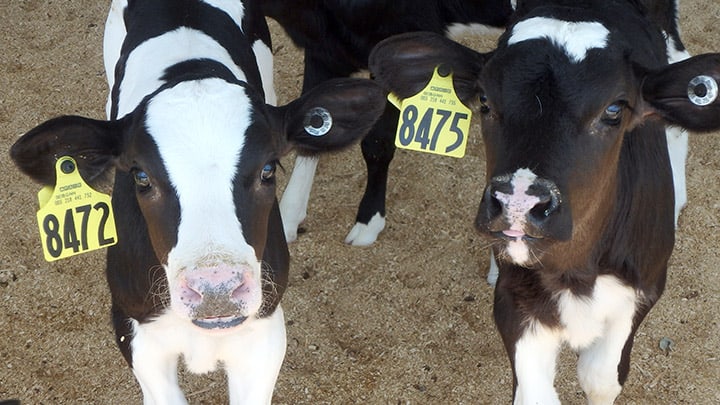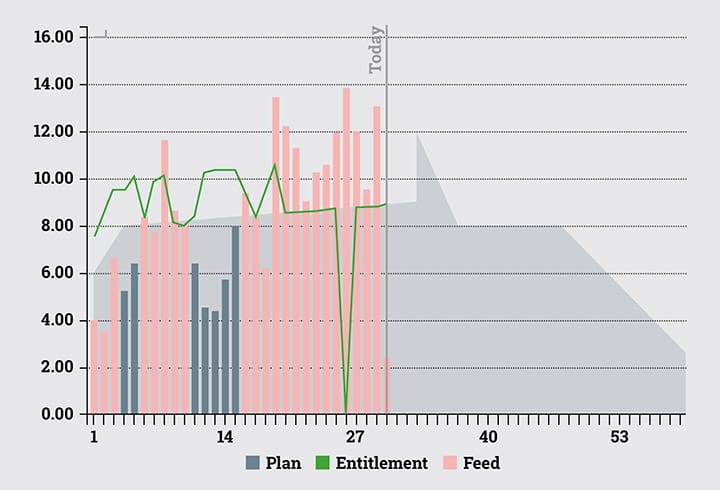“If you aren’t using the 40-Fit option on you autofeeder, both you and your calves may be missing out!” Read more…
Feeding plans: Ad lib vs. restricted

This blog assumes that the reader is already using or is strongly considering using a calf autofeeder system. There are several key decisions to be made when developing the feeding plan for your calves. They are:
- How much milk or milk replacer will the calves be allocated to consume per day?
- How quickly should their milk consumption be “permitted” to increase per day?
Note that the calf autofeeder system uses liters (L) rather than quarts when defining volume measures. For this blog, I will use the term “milk” to refer to whole milk or milk replacer.
Research has shown that the preweaned calf is able to consume 2 to 2.5 lb or more of milk solids per day. This would be equal to more than 8L of milk per day. Why should we feed this much milk? It’s expensive!?
- Calves have nutrient requirements for maintenance and growth. They will use their nutrients to meet maintenance requirements first with remaining nutrients used for growth. Maintenance requirements are determined by body weight of the calf and environment. Temperatures outside the “thermal neutral zone” (<40oF, >80oF) will increase their requirements!
- When more milk is fed there are more nutrients available for growth. In nearly all cases this means more efficient gains (more growth/ unit of feed intake).
- During very cold or very hot weather under limited milk feeding (<4L) there may be insufficient energy intake to maintain body weight and calves will lose weight!
- Higher milk intake is especially important for the youngest calves for two reasons
- Starter intake is negligible for the first 4 weeks of age and doesn’t contribute much to nutrient intake.
- Smaller calves have greater body surface area proportionately which means they lose body heat more readily. Therefore, the environmental temperature (particularly cold temperatures) has a much greater impact on maintenance requirements… They need more milk when it’s cold!
- Younger, smaller calves also have less body reserves – body fat – so are less able to withstand a challenge such as heat or cold stress.
How quickly can we increase milk allocation to calves?
There is a widely held belief that feeding too much milk too soon to a calf leads to scours. This is logical, especially if milk was fed twice a day and at irregular intervals or the liquid diet is of poor quality. One typically sees calves refuse milk in the afternoon if there’s a short interval between the morning and afternoon feedings, leading to higher dumped milk.
However, this is not an issue with the calf autofeeder using the ad lib (free choice) program. In this program, calves are permitted to consume as much milk as they desire, but they are only permitted to consume a limited amount of milk (typically 2 – 3L) during any one meal. When they reach this limit at one meal they must wait 2 hours before being allowed more milk. The ad lib feeding plan typically found on many North American dairies is as follows:

With the feeding plan shown above calves are allowed ad lib milk during period 1. During period 2, calves are limited to 12 L (some calves may not be eating this much) at the beginning of the period and decline to 8 L – the end value. This period stimulates the calves to consume calf starter. During period 4 the amount of milk allocated declines gradually each day until weaning at 2 L. This may need to be adjusted to meet individual operations capabilities and goals.
What have we learned about feeding calves with the ad lib feeding plan?
I have attached a chart of a “typical” calf being fed with an autofeeder from a dairy in the US. This information is available on the Calf App Go program from Foerster Technik (More on this later!). This calf has been on the feeder for 30 days.

The calf entered the feeder at 4 days of age. There is a period where the calf “learns” what the feeder is about. However, within a few days’ intake increases rapidly and has peaked at nearly 14 L after 3 – 4 weeks on the feeder. Note the variation in intake from one day to the next. This is “normal” when calves are fed ad lib. Intake may vary according to changes in weather or other conditions in the calf pen. On this farm at 32 days the milk allocation will be dropped to 8L over 4 days, maintained there for 10 days and then gradually weaned over 14 days. (See the gray shaded area.)
Why not restrict the daily allocation to calves using the autofeeders?
Some farms are concerned about “overfeeding” calves and limit the maximum amount that calves can consume in one day. It is highly discouraged to place limits less than 8L / day. In such situations the calf may consume all their daily allocation within 12 hours and try repeatedly to visit the feeder. This increases occupation time, prevents other calves from drinking and results in more rapid wear on the nipple. In addition, cross sucking is more likely to occur which can damage other calves mammary systems (even if they are very small). They will also suck gates, feeders, and anything in the pen to relieve their boredom/hunger pains. In short, we are developing some abnormal behaviors.
Bottom line: With the ad lib program calves are fed a diet which enables them to achieve their biological potential for growth with the highest feed efficiency they will experience in their lifetime. We are creating an animal that is more likely to be calm and not react adversely to new situations. The calf raiser benefits by having a system where milk is delivered according to individual animal needs and their feeding behaviors at the same time.
Dr. Tom Earleywine, Land O Lakes Animal Milk & Bob James – Calf Blogger
